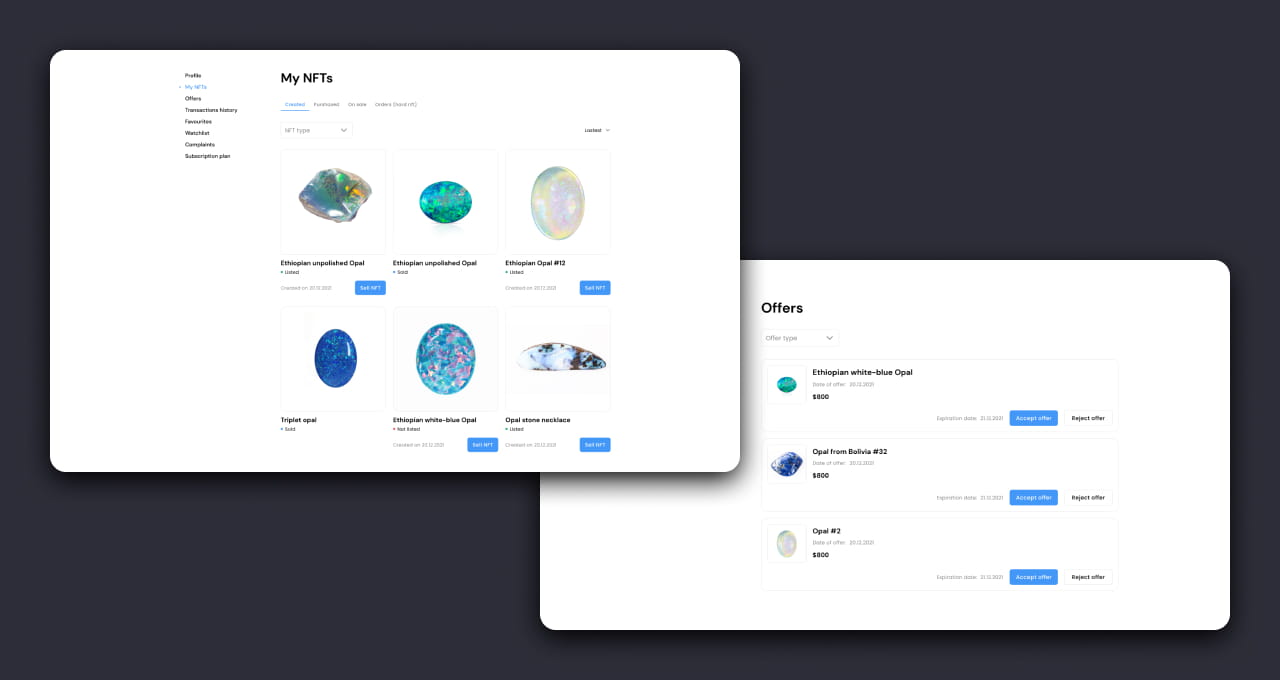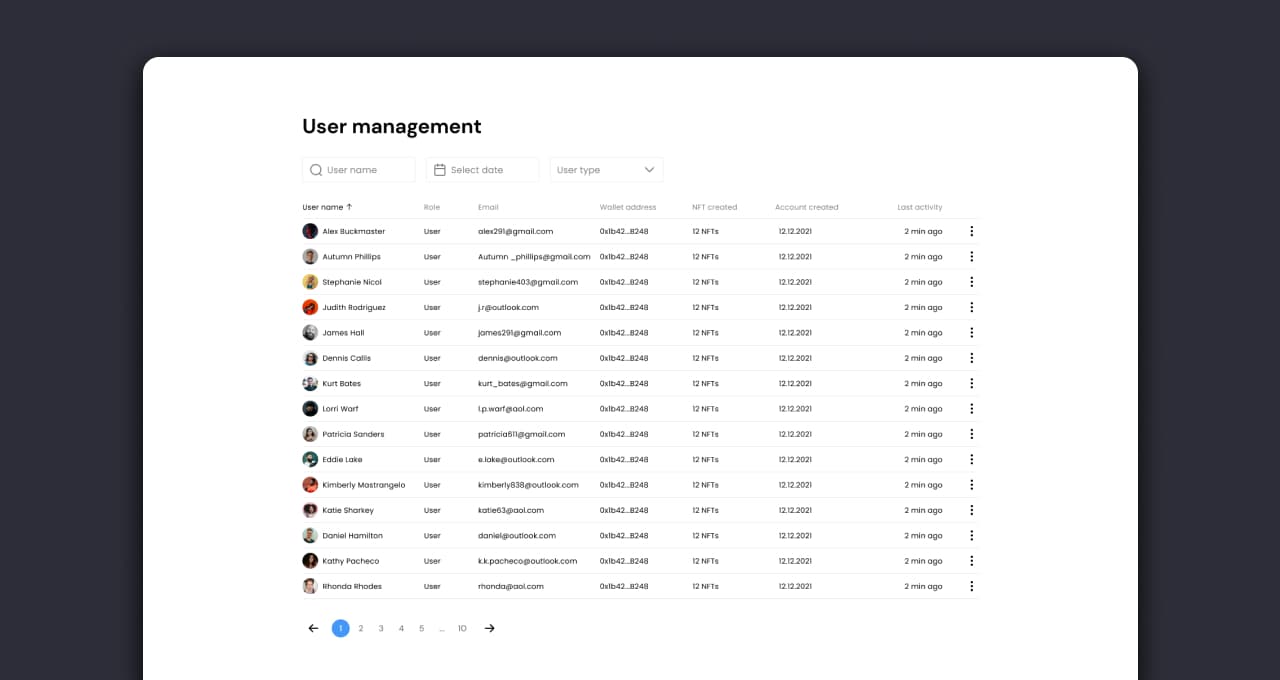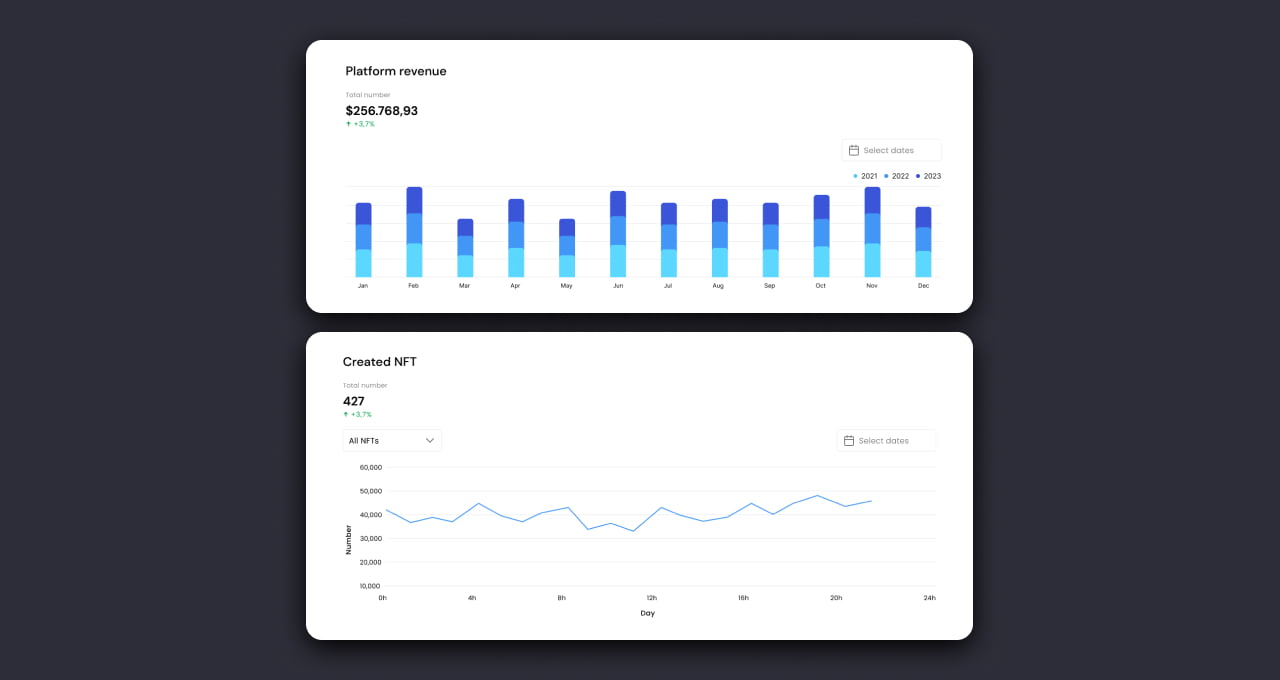
Glasshouse
Niche Flow-powered NFT marketplace for precious stones
- Blockchain
- FinTech
- NFT
- Marketplace
- Metaverse
- Retail
- DAO
- Home
- Success stories
- Blockchain
- FinTech
- NFT
- Marketplace
- Metaverse
- Retail
- DAO
Project goals
Together with the client, we established the key project goals:
- 1
Develop a high-performing NFT platform facilitating smooth NFT minting, auctioning, hosting, and trading
- 2
Provide the basis for a mini-metaverse where users will be able to mine and trade opals and enjoy unique experiences
- 3
Create an advanced, well-structured NFT model
- 4
Enable opal enthusiasts to do away with bureaucracy and operate more effectively with mining organizations
Work done
A robust NFT marketplace intended for opal gemstone fans
Ideation and creation of three different NFT types to be used within the platform
Development of a strategy and mechanism aimed at simplifying interactions between mining companies and opal enthusiasts
Integration with third-party services, including specialized education centers, KYC, a digital wallet, and a shipping service
Hyperledger-powered digital ledger for storing transaction data
Implementation of the escrow mechanism for insuring users against fraud and minimizing the risk of losing money or gems
Convenient web UI for the platform’s users and administrators
Project background
People have always been interested in investing in precious metals like gold and silver. However, these are largely dependent on stocks, and their prices tend to fluctuate a lot, which is why they are viewed by some as a risky investment.
Opal gemstones, on the other hand, are a rare commodity whose price has been steadily growing over time. The demand for opals has been high and the pandemic has also contributed to the increase in their popularity. During the January-July 2021 period, sales of the precious stone on Opal Auctions were up by over 46% compared to the same time period in 2020.
What makes opal gemstones a good investment?
- Widely used in jewelry production
- Scarce commodity that is impossible to industrialize due to the way it is sourced
- Its value is independent of share and property prices
- Opportunity to diversify an investment portfolio and own a real gem that you can touch
the cost of an opal sold at auction in Alaska in 2022
of the world's precious opal produced in Australia
year-old age group represented the biggest increase in opal buyers in 2021
approximate cost of a deposit required to operate an open-cut opal mine
Business opportunity
The client, a keen and experienced opal gemstone enthusiast, came up with a ground-breaking idea that could potentially tackle the most pressing challenges inherent to gem mining and trading, and reached out to the PixelPlex team to polish it and bring it to life.
Despite all their unique characteristics and benefits, opals are challenging to mine. In America, for example, to extract gems on a certain territory, you need to contact a claim owner or mine staff operating on the site and deal with heaps of red tape that comes with becoming a claim holder yourself. Importantly, you need to apply for a special education program and learn how to properly mine opals via the MSHA. As well as this, due to the pandemic, some opal claim holders require appointments before non-claim-holders can mine.
Another aspect worth highlighting is that there is no single, unified, secure platform that would bring together all opal collectors, sellers, buyers, and mining organizations, and enable them to seamlessly and safely interact with each other, trade and showcase precious stones, and document a clear, detailed origin history for each gem. Plus, there’s no platform that offers mining collectives ownership via DAO governance tokens.
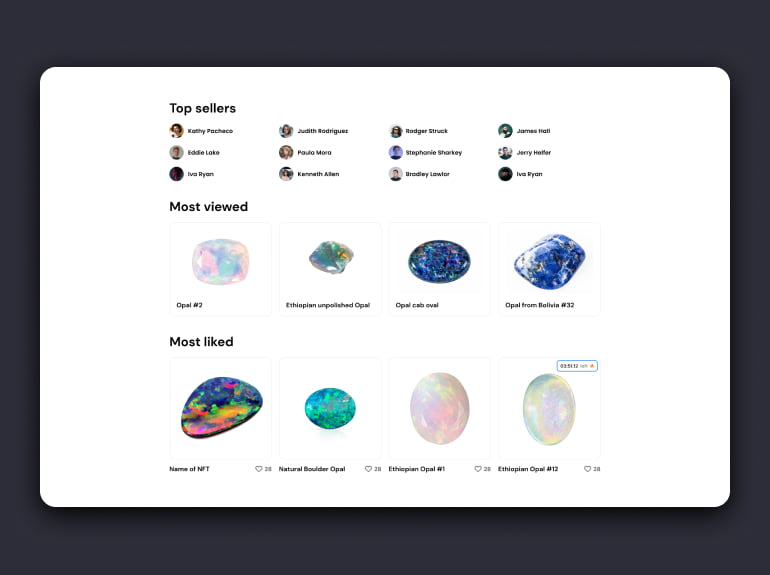
Solution
We have delivered a sophisticated NFT marketplace with metaverse-like features and an elaborate NFT model that empowers opal collectors to mint, auction, and trade 2D and 3D representations of mesmerizingly beautiful opals that contain detailed information about each stone.
The solution also possesses a hard asset NFT functionality, meaning that platform users can enjoy digital images and videos of their opals and also have the physical stones delivered right to their doorsteps.
Crucially, together with the client we developed and implemented a special shareholder NFT functionality that makes it easier and less time-consuming to gain permission to mine opals on a particular site.
Details
Our journey started with mapping out a detailed vision & scope document that foresees all challenges and risks, and selecting the most appropriate blockchain for the NFT platform.Got an idea? Let’s work together
Discovery phase
First of all, we conducted an all-encompassing discovery phase which helped validate the project’s strategy. Our team has:
- advised on the most appropriate tech stack
- mapped out the application architecture
- provided detailed industry-specific security measures
- outlined integration with third-party service providers
- identified functional and business needs for successful project development
- described the NFT functionality
After agreeing with the client on the NFT marketplace’s core architecture, functionality, and third-party partners, we then decided to proceed with an MVP in order to deliver the solution to the market faster.
Why Flow?
Upon exhaustive research executed by our blockchain consulting team, we advised the client to opt for the Flow blockchain for the following reasons:
- Easily scalable and perfectly suitable for building NFT apps
- High transaction speed (around 65,000 tps)
- Low transaction fees (starting at 0.000001 FLOW which is close to $0)
- Treasury account and Flow USDC-multichain USDC Swap API is designed to meet the needs of wallets, exchanges, custodians, and other digital dollar stablecoin applications, reducing the friction to convert USDC across supported chains at no cost
Flow splits the work of processing transactions into four separate nodes that each have their own role and responsibility. Instead of relying on off-chain solutions to scale the network, Flow’s native node subdivisions give it a great advantage in blockchain scalability.
Sophisticated NFT model
When the client presented their idea to us, we realized that the solution required a multifaceted NFT model which could fulfill the project’s objectives. That is why we developed three non-fungible tokens, each of them performing its own separate function:
Art/collectible NFT
A digital 2D or 3D representation of an opal that can be a photo or GIF of a rare gemstone. The given NFT type contains detailed information about the opal’s origin, size, value, trading history, and many other important aspects.
An art NFT can be minted, auctioned, displayed, and traded on the NFT marketplace.
Hard asset NFT
This is a non-fungible token that is underpinned by a physical opal gemstone. The holder of an asset-backed NFT can not only enjoy the benefits of having full ownership over a digitally represented opal but also opt to have it delivered right into their hands to enlarge their physical collection. Gemstone delivery is possible thanks to the NFT marketplace integration with a shipping service provider.
Private shareholder NFT
To mine opals, one needs to contact a special organization engaged in trading shares that permit opal devotees to extract stones on their territory. The process of sealing deals with these shareholders is time-consuming and mundane, leaving many gemstone seekers dissatisfied.
With regard to this, we have developed a private shareholder NFT. This token type represents a share belonging to a certain mining landowner and can be bought by the platform’s user to gain access to digging stones. A private shareholder NFT simplifies the process of transferring rights to shares and contributes to better efficiency.
Key ecosystem participants
Users
NFT marketplace users have the ability to register on the platform, display, put up for sale, trade, and buy both collectible and asset-backed opal gemstone NFTs.
Shareholders
These participants are mining collectives or owners of mining lands who sell or rent their shares to the platform users who want to mine opals on their territory.
The main user roles
The platform owner who is empowered to manage the content and users of the NFT marketplace.
An unregistered user of the platform who can view the content available on the platform. To buy or sell a token, a guest will need to register on the platform.
A mining company representative who handles transfer agent responsibilities and takes care of ownership changes in traded shares for patented claims.
Users who have been registered and verified on the platform.
NFT traders can be:
- Individual shareholders/family owned companies with patent claims
- Mining collectives who don’t own a patent on the claim but have a precious mined opal
- Social media mining collectives
- Mines with jewelry/precious stones that are sold online
Business representatives who have been registered and verified on the platform. Vendors represent existing and new stores which trade opals and/or are interested in trading them as NFTs.
Use case diagram
Core third-party integrations
To ensure the efficient functioning of the NFT marketplace as well as guaranteeing security and a satisfying user experience, our PixelPlex development team has provided integration with the following third-party services:
KYC/AML
Once a user has registered on the marketplace, they will be asked to undergo an AML/KYC procedure. The platform will not have access to the user’s personal information — instead, it will receive confirmation about the validity of the input data from a third-party provider.
We have chosen Shuftipro, our long-standing and reliable partner with an impeccable reputation and clients from 100 countries, as a KYC service provider.
Delivery service
As the client’s vision was to provide not only a digital opal NFT but also to have a physical gem delivered to the asset-backed NFT holder, our team decided to allocate the delivery service to a third-party provider called Shippo.
The delivery functionality will allow the platform users to enter address details, organize and track their delivery, and keep in touch with the service center.
Blocto wallet
A digital wallet is necessary to conduct transactions on the NFT marketplace. After careful analysis, we gave priority to the Blocto wallet, since it offers the following advantages:
- Relative ease of use and navigable UI
- Support for the underlying Flow blockchain
- Flexible, two-staged security model
- Transaction fees are subsidized by the wallet itself
Credit card payment
Considering that some of the platform’s participants might not have previously interacted with blockchain and cryptocurrencies, we decided to include the opportunity to make payments with a credit card too.
We looked carefully into all options available and selected Stripe. The integration with this online payment service provider enables users to pay for the marketplace’s services and trade in USD.
Technologies used
Project features
Payment with both cryptocurrency and credit card
Low NFT minting fee (almost $0)
Smooth and consistent UI
Elaborate NFT strategy
Convenient interaction with 3rd party services
Security of users’ funds provided by the escrow mechanism
Hyperledger-enabled storage
Simplified communication with mining organizations
To be continued… Opal metaverse is underway
The NFT marketplace developed by the PixelPlex team for fans of opal stones has set the stage for an immersive opal metaverse (Opalverse) that has been proposed and ideated by the client.
Together we intend to ramp up our efforts and are already hard at work creating an entire metaverse space where gemstone aficionados will be able to unleash a range of extraordinary experiences, namely:
- Display, view, and interact with unique opal gems in virtual showrooms
- Set off on exciting trips to digital opal mines and search for gems there
- Conduct and participate in thematic virtual workshops and meetups
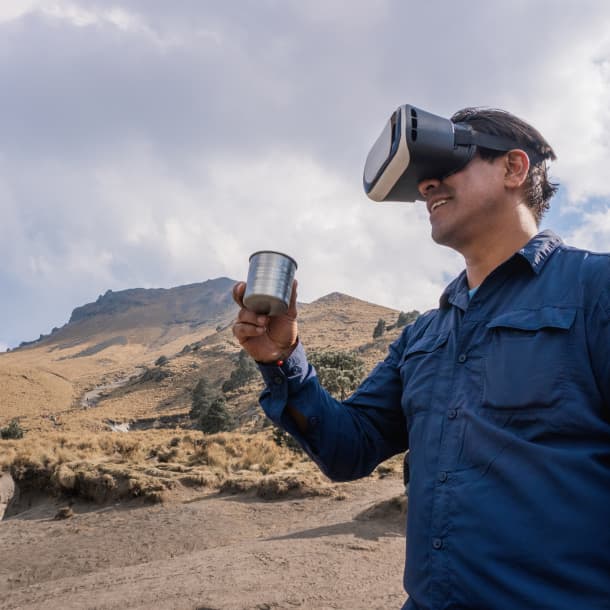
- Services IT R&D RESEARCH & DEVELOPMENT In this ever-evolving tech realm, don't just follow trends — set them.Capitalize on innovation, launch ground-breaking products, and forge new business models for maximum ROI. IT Consulting CONSULTING From complex enterprise tech transformation to the innovative project launch, our team supports businesses at different stages of their projects.Come along, we’ll help you get an edge and play big on the global market. Custom Software Development CUSTOM ENGINEERING Let us have your back in a project of any scale. From user-centric mobile apps to full-blown cross-platform enterprise ecosystems — we’ll bring your concept to life, exactly as you think it should look and work. Mobile App Development MOBILE APP DEVELOPMENT Entrust us with your end-to-end mobile project — from ideation and engineering to app launch and integration.With business growth in mind, we’ll help you hit the market with a slick iOS, Android, or cross-platform app. Mobile App Development iOS App Development Android App Development Cross-Platform App DevelopmentWeb Development WEB DEVELOPMENT Whether you need an app from the ground up or require a legacy system to be updated, we can jump in at any stage.From an accessibility roadmap to post-launch support, we’ll help your business stay strictly legal and competitive. Web Development Web Accessibility Audit Web Accessibility Consulting Accessible Web Development and DesignDevSecOps DevSecOps Ensure your software's integrity and efficiency from conception to compliance. UI/UX Design UI/UX DESIGN Give us the pleasure of adding our secret sauce to your app.We’ll create beautiful screens at the front while breaking the limits of what’s behind them to help your app get to beyond-plausible business achievements. QA & Software Testing QA & SOFTWARE TESTING Engage us for integrated quality assurance services, and our experts will advise on QA strategy and optimize software testing costs.We’ll balance manual testing with QA automation to ensure consistent performance for all possible use cases and devices.
- Technologies Blockchain BLOCKCHAIN DEVELOPMENT Blockchain Development Blockchain Consulting NFT Development STO Development ZK Rollup Solutions Enterprise Blockchain Development Smart Contracts Development Smart Contract Audit DApp Development Cryptocurrency Exchange DevelopmentData Science DATA SCIENCE Transforming data into growth strategies is our specialty.Leverage our expertise to unlock the potential of your big data and diverse digital assets, driving business growth. Big Data Consulting Data Analytics Business Intelligence Data VisualizationMachine Learning and AI ARTIFICIAL INTELLIGENCE Machine Learning Predictive Analytics Computer Vision Custom AI Development Chatbot DevelopmentAR & VR AUGMENTED VIRTUAL REALITY Immerse your customers into a universe of unimaginable and give them truly novel experiences with AR, VR, and Mixed Reality.We'll help define a proper business concept and find a balance between legacy workflows and next-gen customer engagement solutions. Metaverse METAVERSE We create tools, assets, and ecosystems to seamlessly merge real-life and digital worlds within your Metaverse projects.It could be a multi-layer virtual space or a unique artwork item. Either way, we’ll deliver it — ready and working. Connected Devices (IoT) INTERNET-OF-THINGS Aching to handle digital and physical asset management? We build load-resistant IoT services, both enterprise and consumer.Hit us with IoT consulting, app development, back-end engineering, or existing infrastructure revamping – we’ll nail it down.
- Industries FinTech & Banking FINTECH & BANKING As traditional finance goes digital, we are committed to building efficient ecosystems and better engagementThink of customized FinTech solutions with tamper-proof transactions and storage, progress transparency and automation — and we’ll make them see the light of day. Retail & eCommerce RETAIL & ECOMMERCE Whether you market B2B or B2C, commerce tech trends are all about value-driven purposes, global sustainability, hybrid shopping journeys, and extra-resiliency.Let your clients know that there’s more to your brand than meets the eye by creating unique customer experiences in all your stores. Supply Chain & Logistics SUPPLY CHAIN & LOGISTICS To make things easier for all vendors, we deliver apps for route and cost optimization, vehicle operational support, and better dispatch time efficiency.With focus is sustainability, resilience, transparency, and immutability, let’s get your transformation going. Healthcare HEALTHCARE Custom healthcare software solutions are aimed at helping you ensure accurate diagnosis, better patient engagement, and positive healthcare outcomes.Whether you require a patient management solution, practice management software, EMR/EHR system, or ML-enabled diagnostics – we’ve got you covered. Real Estate REAL ESTATE Keep up with digital innovation trends by accelerating enterprise transformation and scaling, leveraging data and orchestrating workflows.Whether you manage and sell commercial facilities or invest third-party capital, our integrated solutions help you make the most of it. Oil & Gas OIL & GAS With mobility and digital technologies standing to change the game and define leadership, our mission is to get you digital-first.Resolve operational and conceptual issues by introducing clear tech vision, feasible architectures, and flexible software to take business extension off limits.
- Solutions Know-Your-Transaction KYT platform ensures financial integrity, compliance, and proactive risk management. Control your operations seamlessly with real-time API integration. DocFlow Secure workflows, decentralized storage, and total document control. Streamline your processes with our business document management system. Arbitrage Bot Alternate your yield channels, maximize investment efficiency, customize trading strategies, and execute profitable low-risk transactions. CryptoAPI Connect your dApps to blockchains commission-free. No need for heavy database upload, infrastructure updates, or a dedicated engineering team. OTC Hawk Redefine wealth and portfolio management at your firm, outpacing your competitors. Make crypto/fiat trading easy and profitable for your clients.
- Success stories Blockchain Government & Enterprise Energy & Utilities Financial Services Supply Chain Healthcare Retail & eCommerce See all projects
- Company About us Team News Careers Scholarship CSR Contacts
- Blog
